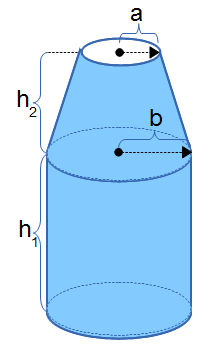The Bottle Content Weight calculator computes the weight of a bottles contents based on the dimensions of the bottle and the mean density of the material. 
INSTRUCTIONS: Choose the length units you wish (e.g. centimeters or inches) and enter the following:
- (a) neck radius at the top of the bottle
- (h2) height of the tapered neck section
- (b) base section's radius
- (h1) height of the bottle's base that is a constant diameter along it's length from the bottom base to the beginning of the taper.
- (mD) mean density of contents.
Bottle Content Weight (M): The calculator returns the mass in grams. However, this can be automatically converted to compatible units via the pull-down menu.
Bottle Calculators
- Surface Area of a Bottle: This computes the surface area of a bottle shaped object based on the dimensions.
- Mass of the Contents of a Bottle: This computes the weight or mass of a bottle shaped object based on the dimensions and the density of its contents.
- Volume of a Bottle: This computes the volume of a bottle shaped object based on the dimensions.
- Bottle Coating Amount: This computes the volume of material needed to coat the surface area of a bottle shaped object.
The Math / Science
The formula for the mass of a bottle shaped object is the volume of the bottle times the density of the material. Assuming normal gravity, this also provides the weight. Geometrically, a bottle shaped object is the combination of right circular cone with a frustum defined by base radius (a) and top radius (b) and height (h2) in between and a cylinder of radius (b) and height (h1). The volume is calculated and then multiplied by a mean density (mD) to provide the mass of the shape.
Mean Density Table
| Common Mean Densities in Kilograms per Meter Cubed (kg/m3) | ||
|
Fluids
Fuels
Market-Ready Grains |
Metals
|
Earthen
Synthetic
Organic
|
| Mean Density Lookup Function | ||
Mean density is scientifically volume divided by mass. There are various unit for density adopted by cultures and industries. Common units for density included the following:
- kilograms per cubic meter (kg/m3)
- grams per cubic centimeter (g/cm3)
- grams per liter (g/L)
- pounds per cubic feet (lb/ft3)
- ounces per cubic inch (oz/in3)
- pounds per barrel (lb/bbl)
- pounds per bushel (lb/bu)
If you want to identify a material by its density, use the Density Within Range tool.

Weight is technically the downward force that a mass exerts based on the force of gravity and the mass of the object. On the surface of the Earth, mass and weight are often interchanged. In some places, objects are sold by the gram (mass), and in other locations, the same objects are sold by the ounce (weight).
The Weight Calculators use the dimensions of an object and its shape to compute the objects volume. They then apply a density associated with a material to estimate the objects weight.

Weight Calculators
- Weight from Area, Height and Density
- Cube Weight
- Box Weight
- Cone Weight
- Cone Frustum Weight
- Cylinder Weight
- Slanted Cylinder Weight
- Semicircle Weight
- Triangular Weight
- Quadrilateral Weight
- Pentagon Weight
- Hexagon Weight
- Heptagon Weight
- Octagon Weight
- Nonagon Weight
- Decagon Weight
- Hendecagon Weight
- Dodecagon Weight
- Paraboloid Weight
- Polygon Pyramid Frustum Weight
- Sphere Mass
- Sphere Cap Weight
- Sphere Segment Weight
- Sphere Shell Mass
- Oblate Spheroid Mass
- Ellipsoid Weight
- Torus Weight
- Bottle Weight
- Bottle Content Weight
- Chamfer Weight
- Ring Weight